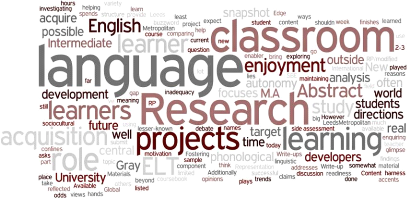|

Ministry of Higher Education and Scientific
Research
Pre-service Teacher's Training College Bouzareah
Department of
English
Enhancing Learner's Autonomy in EFL Context The Case
of Secondary School Students in Algeria
This research paper submitted for partial
fulfillment
of the requirement of the degree of
Secondary School Language
Teacher
Submitted By :
V' Tahani SALHI
V' Rayane BOUAMINE
Directed By :
V' Dr. Kenza NEZZAR
Academic Year
2019-2020
Abstract
As the learner autonomy is a complex concept , this study aims
to assess its level or state among the Algerian Secondary Learners. To do, a
large investigation of learner autonomy and its related concepts is made and
then a general overview on the Algerian Educational System and its main
objectives on English Teaching and some other interesting methods such as
Communicative Language Teaching and Cooperative Learning and the use of ICT are
also seen as deeply as possible. Secondary School teachers responded to a
specific questionnaire that surrounded the learner autonomy concept in the four
main categories: teacher, learner, classroom and outside of classroom.
List of abbreviations
CBA : Competence Based Approach
CEFR : Common European Framework for Reference
CL : Cooperative Learning
ECT : English Communicative method Teaching EFL
: English Foreign Language
ELT : English Language Teaching
ICT : Information and Communication Technologies
TTT : Teach-To-Test
Figure # Title Page
List of figures
1 Learner autonomy context
01
2 Fitts and Posner 3-Stage Model
09
3 Learner autonomy approaches
12
4 Autonomy dynamic model
26
5 Teacher autonomy state
62
6 Learner autonomy state
63
7 Classroom autonomy state
64
8 Outside of classroom autonomy state
65
Table # Title Page
List of tables
1 Learner autonomy definition
07
2 Fitts & Posner Stages of Motor Skill
Learning 10
3 Comparison between Autonomous and
Non-autonomous Classrooms 24
4 English Textbooks in Algeria From 1968 to
2003 45
5 New English Textbooks
46
Table of contents
Acknowledgements
Dedication
Abstract
List of abbreviations
List of figures
List of tables
Page
General Introduction 01
Chapter I - Literature review on learner autonomy in
education 04
1 Introduction 04
2 What is autonomy? 05
3 Autonomy within the learning stages
08
4 Autonomy levels 10
5 Autonomy approaches 12
6 The autonomous teacher 16
7 The autonomous teacher characteristics
18
8 Autonomous learner prerequisites (conditions)
19
9 Autonomous learner characteristics
20
10 Teacher autonomy and learner autonomy
22
11 The autonomous classroom
23
12 The learner motivation and self-esteem
24
13 The autonomy dynamic model
25
14 The C.E.F.R for Languages assessment grid
27
15 Fostering Learner Autonomy
27
16 Language skills and attended competencies
34
17 Conclusion 35
Chapter II - The Algerian Educational System and
approaches to 36
English Language Teaching
1 Introduction 36
2 The Algerian Educational System
37
3 The English language teachings objectives
38
4 The English language teachings approaches
46
5 The Communicative Language Teaching (CLT)
approach 54
6 The Cooperative Learning
55
7 The use of ICT in EFL 56
8 Conclusion 57
Chapter III- Data
Collection, Interpretation, Findings and solution
58
1 Introduction 58
2 The teacher's Questionnaire
58
3 Collected Data 61
4 Interpretation 65
5 Findings 67
6 Enhancing learner autonomy
68
General Conclusion 69
Bibliography 70
Appendix 72
-1-
General Introduction
The complexity of the learner autonomy concept is well known and
have many aspects.
Lizzie Pinard presented the whole aspect of learner autonomy in
the global manner :
«The average language learner spends around 2-3
hours a week in the classroom, implying that for acquisition to take place,
exposure to the target language shouldn't be limited to classroom confines.
Indeed, learner autonomy is somewhat of a buzzword in ELT - we recognize the
inadequacy of classroom time with regards to acquisition, as well as the issue
of syllabus structure often being at odds with learner `readiness' to acquire,
meaning that what learners do outside class time becomes of the utmost
importance. However, there is often a gap between what we expect our learners
to do outside the classroom and how we help them to do it. This project
explores ways of helping learners harness the target language in their
environment, real and/or virtual, effectively, and the role that learning
materials, and their use in the classroom as well as beyond it, can play in
scaffolding the process, in addition to stimulating and maintaining motivation,
curiosity and the desire to acquire.»
She described the whole context as shown in the following figure
(Fig.1).

Fig. 1: Learner autonomy context
(Pinard:2020).
-2-
General Introduction
Beyond this complex context, there are more factors affecting the
learner autonomy such as:
? The learner motivation and self-esteem;
? The previous acquired competencies and skills; ? The classroom
heterogeneity;
? The outside of classroom.
As many researchers are focusing on learner autonomy as an
ultimate goal in teaching, the present aims to help out with a new approach
guided by the following research questions and its sub-questions and our
hypothesis.
-Research question, sub-questions and
hypothesis
The main research question is put as follows:
How secondary school learners autonomy can be
enhanced?
The response to that question can be gotten clearly when
answering its sub-questions :
1-At what state the Secondary School learners autonomy
is?
2-What are the solutions to enhance secondary school
learners autonomy?
Our Main hypothesis to that issue is:
-Secondary school learners are not
autonomous.
To conduct this research, the following methodology is
adopted.
-Methodology of the research
There are nine types of research in Applied Linguistics which
are: experimental, ethnography, case study, classroom observation,
introspective, elicitation, interaction analysis, and program evaluation.
-3-
General Introduction
Choosing the research type is mainly based on the nature of the
research itself.
Learner autonomy is a phenomenon that actually happens both
inside and outside the class. A case study is selected because:
«A case study is an empirical inquiry that
investigates a contemporary phenomenon within its real- life
context.»
Nunan (1967:76).
Accordingly, there are three types of case study: case study
according to the purpose of research, case study in terms of the number of
cases, case study according to the units of analysis. In this research we are
concerned with the first type which is case study according to the purpose of
research.
The case study according to the purpose of research includes
three sub-categories: descriptive, explanatory, and exploratory.
Firstly, the descriptive case study focuses on describing an
object of phenomenon; it gives a wider attention to the characteristics of a
certain issue, this is what is done in chapters I and II, entitled
respectively: «Literature review on autonomy in education» , and,
«The Algerian Educational System and approaches in teaching English».
Secondly, the explanatory case study studies the reasons behind a definite
problem, more importantly, it explains why it happens.
Thirdly, the exploratory case study aims at studying a given
problem, and also, undertaking a specific issue in order to look for ways
through which the existing situation that can be improved, that is the
practical part of this research, fully presented in chapter III entitled
«Data Collection, Interpretation, Findings and Solution».
Thus, the research is a descriptive exploratory case study.
Its major concern is to focus on the concept of autonomy and the manner to
enhance it.
-Scope of the research
This research is limited to learners of Secondary School first
year and the assessment of autonomy is given to teachers because of their daily
interaction with learners.
-4-
I-Literature review on learner autonomy in education
1-Introduction
This chapter aims to clarify the concept of learner autonomy
in almost of all its related aspects and beginning by the definition of that
concept as seen by researchers in its conceptions and misconceptions.
Then learning stages as defined by Pitts and Posner are
introduced for the first time in such like research in order to explore more
learner autonomy levels as explained next to this model.
To «extend the idea of learner control over the planning
and evaluation of learning to the curriculum as a whole» as Benson said,
all known learner autonomy approaches as presented and are followed by concepts
of autonomous teacher and its characteristics as the source of learning and
seconded by the same concepts to the target of learning which is the learner
itself and the classroom in which he receives education. This learner is also
bound to its affective side such his proper motivation and self-esteem as
regard to his needs to learn language.
The most recent autonomy model is the dynamic model of Maria
Giovanna Tassinari which explains the ways to manage the own learning and thus
very interesting for both teacher and learner. To help reaching that aim, the
CEFR assessment grid is presented to determine competencies matter to be
autonomous on.
Finally, and as the keywords: fostering, promoting and
enhancing are closely used for each other, enhancing learner autonomy is
presented in a detailed manner to make the research more clear by defining the
learner's language skills leading him to acquire the aimed language
competencies and making him autonomous..
-5-
| 


